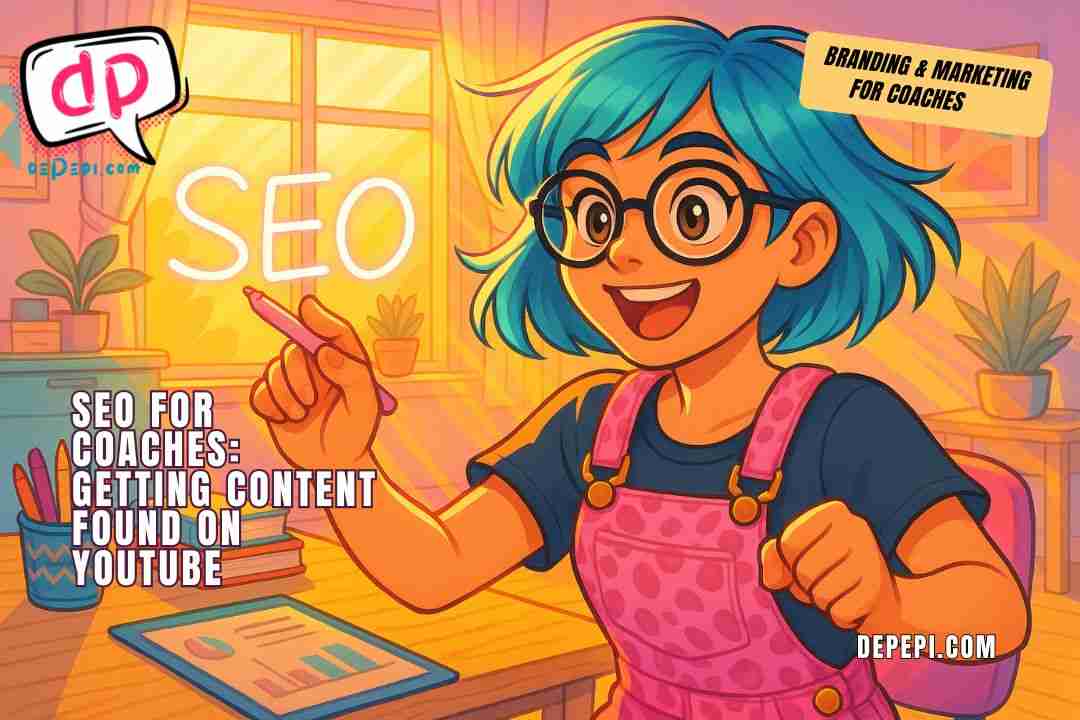SEO on Youtube: Getting Coaching Content Found

For coaches, YouTube can be more than just a platform to share advice. It can be the engine that drives business growth, client leads, and brand authority. But uploading great videos isn’t enough. YouTube is the second-largest search engine in the world, and its algorithm isn’t just watching your content; it’s watching how people interact with it. This means that you need SEO on YouTube.
Thus, mastering SEO is non-negotiable. This doesn’t mean stuffing keywords into your content like a robot, but rather understanding how YouTube thinks and how your audience searches. SEO is what helps people find your content in the first place. Combine it with a deep understanding of YouTube analytics and the recommendation algorithm, and you’ve got a roadmap for turning one-off views into a thriving audience.
Why Coaches Should Care About SEO ON YouTube
YouTube is saturated with content, but not all of it is optimized. That’s your opportunity.
If your content isn’t showing up in search results or on the recommended feed, it may as well not exist. Coaches who embrace YouTube SEO don’t just wait for viewers; they earn them.
And it matters, because:
YouTube videos often rank in Google search results.
Viewers who discover your video through search have higher intent.
SEO helps compound your visibility over time—one video can bring traffic for years.
Imagine posting a video today that still drives client inquiries six months from now. That’s the power of good SEO.
The Building Blocks of YouTube SEO
Let’s go step-by-step through the SEO elements that matter most for discoverability and how you can apply them to your coaching content.
1. Keyword Research
Before you hit record, start with search intent.
Use Google’s Autocomplete to find what your audience is searching.
Think in terms of problems and aspirations: “how to set boundaries,” “morning routine for mindset,” “confidence tips for introverts.”
Choose long-tail keywords that are specific but have low competition. Example: Instead of “confidence coaching,” try “how to build confidence before a job interview.”
Tip: If you’re a life coach, use client language in your keyword phrases. What do they actually say when they describe their challenges?
2. Optimized Titles that Hook and Rank
Your title needs to do two things: grab attention and include keywords.
Front-load your main keyword. Example: “Confidence Tips for Coaches | 5 Ways to Show Up Authentically”
Keep it under 60 characters to avoid truncation.
Don’t clickbait, but do create curiosity. “The #1 Confidence Tip No One Talks About (That Actually Works)” is better than “Confidence Coaching 101.”
3. Descriptions That Work for the Algorithm and the Viewer
YouTube scans your video description for keywords, so give it something to work with.
In the first 2–3 lines, include your target keyword naturally.
Next, write a few short paragraphs explaining what the video covers, including any relevant resources, and link to your coaching offer or lead magnet.
Use timestamps if your video is longer. YouTube loves clear structure.
Bonus: Add related hashtags (like #confidencecoaching or #lifecoach) at the bottom of your description. These create clickable tags above the video title.
4. Tags: Less Important, But Still Useful
YouTube has downplayed the role of tags, but they still help with misspellings and related topics.
Use a mix of specific and broad tags: “confidence tips,” “life coach advice,” “how to be more assertive,” etc.
Include variations of your main keywords.
Understanding the Recommendation Algorithm
Not all YouTube traffic comes from search. In fact, much of it comes from the recommendation engine (those videos that autoplay next or appear on the homepage).
How do you get on that feed?
1. Click-Through Rate (CTR)
If no one clicks your video, YouTube stops showing it. Your thumbnail and title need to earn the click.
Use expressive facial expressions, bold text, and emotional cues in thumbnails.
Test different styles: contrast, colors, or curiosity-driven images.
2. Watch Time and Average View Duration
YouTube cares deeply about how long people watch your video.
Hook viewers in the first 10 seconds: Ask a question, state a bold truth, or show a teaser.
Avoid long intros. Get to the point, or you’ll lose them.
Use pattern interrupts (graphics, camera angle shifts, music changes) to keep attention.
Tip: Add a mid-video CTA like, “If this is helpful so far, give it a like. It helps the algorithm know this content matters.”
3. Session Time
It’s not just about your video; it’s about keeping users on YouTube.
Use end screens to suggest other videos.
Create playlists that encourage people to look for your content.
Encourage subscriptions in a natural way: “If you want more content like this, hit subscribe so you don’t miss the next one.”
YouTube Analytics
Once your videos are live, analytics become your secret weapon. Don’t post and ghost—analyze and adapt.
Key Metrics to Watch:
Impressions: How often your video was shown to viewers.
Click-Through Rate (CTR): % of impressions that turned into views.
Average View Duration: How long people stick around.
Audience Retention: See where people drop off. Was your intro too long? Did you ramble mid-video?
Traffic Sources: Know where your views are coming from (Search, Suggested, External).
Coaches who thrive on YouTube don’t guess: they test, review, and refine. Every upload is a feedback loop.
Common YouTube SEO Mistakes Coaches Make (And How to Fix Them)
Uploading without a strategy
→ Fix: Do keyword research first. Plan your title before you script your video.Treating YouTube like Instagram
→ Fix: Instagram favors aesthetics. YouTube favors value per minute. Depth matters.Generic titles like “Mindset Coaching #5”
→ Fix: No one’s searching for that. Make titles that solve a specific problem.Ignoring thumbnails
→ Fix: Thumbnails matter as much as titles. Test and update them over time.Not using YouTube to build your list or funnel
→ Fix: Include strong CTAs in the description. Offer a freebie. Link to your website.
When SEO Becomes a Trap
The rise of YouTube SEO has led some coaches to treat the platform like a content farm. Every video is crafted around search trends, with robotic delivery and keyword-stuffed language. It gets clicks… but loses hearts.
“Overemphasis on SEO risks turning coaching channels into keyword farms, losing authenticity for the sake of algorithmic reach.”
Viewers want humans—coaches who connect and who care.
Here’s the balance:
Use SEO to get discovered.
Use authenticity to get remembered.
Don’t lose your voice in the pursuit of traffic.
The best-performing coaching videos aren’t always the most polished—they’re the most genuine. The ones that make people feel seen, heard, and hopeful.
How to Blend Strategy with Soul
To wrap up, here’s a simple system coaches can follow to grow their YouTube presence without losing their authenticity:
1. Search-Driven Topics
Start with what people are looking for, but make it personal.
Keyword: “how to stop people-pleasing”
Video title: “How I Finally Stopped People-Pleasing (As a Life Coach)”
2. Storytelling Structure
Use real stories and case studies. Frame the video like a coaching session.
Problem
Personal story
Coaching insight
Actionable takeaway
CTA
3. SEO-Friendly Setup
Before publishing, ensure:
Keyword in title
Keyword in description
Engaging thumbnail
Tags added
Playlist placement
4. Engagement Layer
Invite comments and interaction. Ask open-ended questions like:
“Have you dealt with this before?”
“What’s your go-to tip for [insert topic]?”
Engagement boosts your ranking and builds community.
5. Repurpose for Reach
Turn your video into:
Instagram Reels
LinkedIn posts
Podcast audio
Blog articles
YouTube becomes the hub, and everything else amplifies it.
Need Help?
Join Branding and Marketing for Coaches or get my DP framework. Don’t be left behind!






